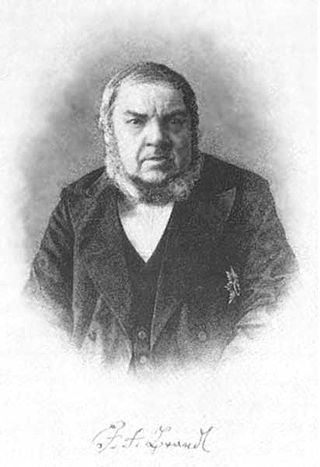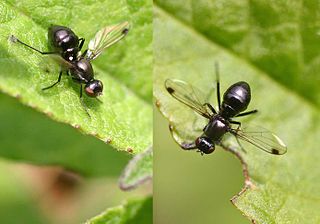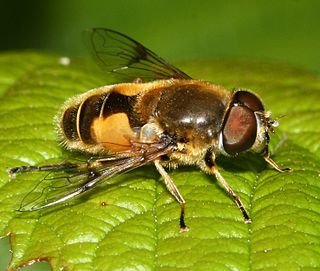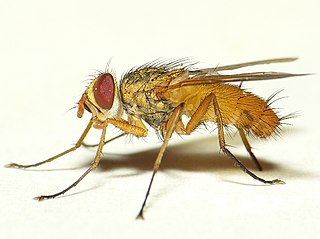
Voeltzkowia is a genus of skinks.

Johann Friedrich von Brandt was a German-Russian naturalist, who worked mostly in Russia.

The Sepsidae are a family of flies, commonly called the black scavenger flies or ensign flies. Over 300 species are described worldwide. They are usually found around dung or decaying plant and animal material. Many species resemble ants, having a "waist" and glossy black body. Many Sepsidae have a curious wing-waving habit made more apparent by dark patches at the wing end.

The telson is the posterior-most division of the body of an arthropod. Depending on the definition, the telson is either considered to be the final segment of the arthropod body, or an additional division that is not a true segment on account of not arising in the embryo from teloblast areas as other segments. It never carries any appendages, but a forked "tail" called the caudal furca may be present. The shape and composition of the telson differs between arthropod groups.

Latris lineata, the striped trumpeter, common trumpeter, copper moki, Hobart-town trumpeter, kokikohi, real trumpeter, Tasmanian striped trumpeter or Tasmanian trumpeter, is a species of marine ray-finned fish belonging to the family Latridae, the trumpeters. It is native to rocky reefs in the temperate oceans of the southern hemisphere.

Diplura is a genus of South American curtain web spiders that was first described by C. L. Koch in 1850. It is found in South America and Cuba belonging to the subfamily Diplurinae. They possess a lyra on their prolateral maxillae. Diplura species can be distinguished from Trechona sp. by the number of setae on this lyra. They differ from Harmonicon sp. by the leg formula and the shape of the lyra bristles.

Fregetta is a seabird genus in the austral storm petrel family Oceanitidae.

Eristalis horticola is a Palearctic species of hoverfly.

Acemya is a genus of flies in the family Tachinidae.

Leskia is a genus of flies in the family Tachinidae.

Montsecosuchus is an extinct genus of atoposaurid crocodylomorphs. It is the replacement generic name for Alligatorium depereti, which was described in 1915 from the Montsec Lithographic Limestone quarry of Spain. Fossils found from this locality are from the Early Cretaceous, being Upper Berriasian-Lower Valanginian in age, belonging to the La Pedrera de Rúbies Formation While many publications concerning atoposaurids after 1915 have included mentions of A. depereti, none has offered a redescription or revision of the species, though some recognized that great differences existed between it and other members of the genus. In these publications, the skull of A. depereti was shorter in relation to body length than any other species of Alligatorium, and this may have been evidence for the genetic distinction of the species, although no replacement name was proposed. However, better preparation of the holotype specimen MGB 512, a nearly complete articulated skeleton embedded in a limestone matrix now housed in the Museu de Ciències Naturals de Barcelona, allowed for a revision of the species in 1990 in which the name Montsecosuchus was first used.
Hypselodoris peasei is a species of sea slug or dorid nudibranch, a marine gastropod mollusk in the family Chromodorididae.

Alvania lineata is a species of minute sea snail, a marine gastropod mollusk or micromollusk in the family Rissoidae.

Oliver Jens Schmitt is a professor of South-East European history at Vienna University since 2005. He is a member of the Austrian Academy of Sciences.
Max Gaede was a German engineer and entomologist of international fame who described several hundred of new species of Lepidoptera, mainly African Noctuidae.

Eryciini is a tribe of flies in the family Tachinidae

Sphenella is a genus of the family Tephritidae, better known as fruit flies.

Terebellides is a genus of polychaete worms in the family Trichobranchidae.

Isoctenus is a genus of South American wandering spiders first described by Philipp Bertkau in 1880.

Xeroleuca is a genus of air-breathing land snails, a pulmonate gastropod in the subfamily Helicellinae of the family Geomitridae, the typical snails.


















